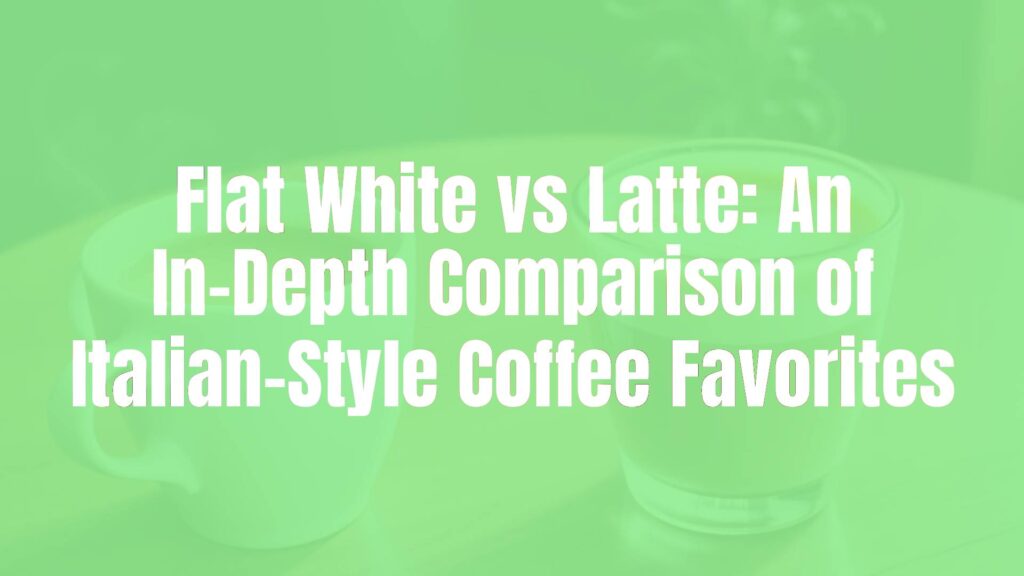Flat White vs Latte: Understanding Two Creamy Coffee Classics
Origins and Evolution
While both the flat white and the latte are intertwined with Italian espresso traditions, they have distinct stories. The latte (or “caffè latte”) traces its roots directly to Italy, where it simply means “coffee with milk.” It has been enjoyed in Italian households for generations, often as a breakfast beverage. The flat white, meanwhile, originated in Australia or New Zealand (depending on whom you ask), but is deeply inspired by Italian espresso bar culture and milk-based coffee drinks.
Key Ingredients and Proportions
The similarities between a flat white and a latte are striking at a glance: both feature espresso and steamed milk. However, the proportions set them apart. A classic latte is typically made with a single or double shot of espresso, larger amounts of steamed milk, and a small layer of foam. The flat white uses a similar quantity of espresso but much less milk, resulting in a stronger coffee-to-milk ratio and a thinner microfoam layer.
Preparation Methods and Technique
Both drinks start with fresh espresso, but the milk preparation is crucial to their character. A latte’s milk is steamed for a creamy texture and topped with a light cap of froth. In contrast, a flat white prioritizes a velvety, finely textured microfoam, poured to blend seamlessly with the espresso, creating what’s sometimes called a “wet paint” effect on the surface. The intention is to highlight the espresso’s flavor while still providing a creamy mouthfeel.
Flavor, Texture, and Appearance
The latte is smoother and milkier, offering a subtler coffee kick and a comforting creaminess. It’s usually served in a larger cup, often between 240–350 ml (8–12 oz), with a visibly thick layer of foam. The flat white, on the other hand, is more robust—thanks to its smaller serving size (about 150–180 ml or 5–6 oz) and higher coffee concentration. It boasts a silky mouthfeel (from the microfoam) with little to no distinction between the foam and milk layers.
Serving Styles and Presentation
Lattes are often served in larger glasses or wide cups and can sometimes be customized with syrups or sweeteners. Latte art is commonly seen, thanks to the milk froth. Flat whites, traditionally presented in smaller ceramic cups, also lend themselves to intricate latte art, but the focus is more on the balance of espresso and milk rather than impressive foam patterns.
Common Misconceptions
A frequent confusion is that a flat white is merely a small latte or, conversely, that both drinks are essentially the same. The real distinction lies in milk texture and ratio: flat whites must have microfoam with minimal bubbles, while lattes have a thicker foam cap. Another misconception is that flat whites contain more caffeine; in truth, they generally use the same shot of espresso as lattes (though proportions vary by café).
Frequently Asked Questions
Can I order a flat white or latte in Italy? In traditional Italian cafés, you’ll find “caffè latte,” but flat whites are less common outside specialty coffee shops.
Which is stronger? A flat white offers a bolder espresso flavor due to less milk diluting the coffee, though the actual caffeine content typically matches that of a latte.
Are the foam textures really that different? Yes! Flat whites focus on microfoam that is integrated and smooth, while lattes emphasize a lighter, more pronounced foam layer atop the drink.
Conclusion: Choosing Between Flat White and Latte
The choice between a flat white and a latte depends on your preference for milk-to-coffee strength and texture. Choose a latte for a creamy, mellow coffee experience, or a flat white if you want a drink where the espresso remains at center stage, wrapped in a delicate layer of velvety milk.

